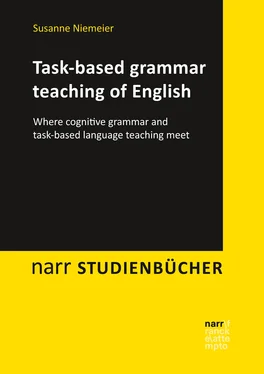It is evident that more than the choice of lexical and grammatical elements is involved in formulating what LANGACKER calls a “usage event”. His definition of a usage event is that it is an
… instance of language use as initiated by a language user who is in command of not only the linguistic expression but also other factors such as memory, planning, problem-solving ability, and general knowledge of the world, as well as a full apprehension of the physical, social cultural and linguistic context. (LANGACKER 2000: 9)
A speaker needs to invoke all kinds of knowledge in order to convey the particular perspective s/he intends to convey. L1 speakers share such knowledge because it is conventionally encoded in their language, and such shared background allows them to select the linguistic means to get their perspective across. However, L2 speakers do not have the same access as native speakers to the linguistic conventions encoded in the L2, they may have different background knowledge and possibly different perceptions of the context. For example, English uses “at this moment”, whereas German uses “in diesem Moment” – ‘in’ as a three-dimensional container preposition indicates that a ‘moment’ might be perceived as somewhat longer by Germans than by native English speakers, who use the zero-dimensional ‘at’, whereas containment (of time) is implied in the German language.
To use another example, the progressive aspect is not grammaticalized in German, which is why German learners of English usually have major problems with its use in English. In English, every activity or process needs to be scanned for ongoingness, whereas German normally leaves this open. A sentence such as “Daria reitet” can either mean that she is doing it right now (“Schau mal da hinten auf dem Feld, da reitet Daria”) or that it is her hobby (“Daria reitet immer am Dienstag”). In English, however, there is a clear differentiation between “Daria is riding” for the first German sentence and “Daria rides” for the second German sentence and speakers of English have to select which of these two different meanings they want to express. Progressivity can of course also optionally be expressed in German, but only with lexical – i.e., not with grammatical – means (“sie ist gerade am Reiten”, “sie reitet gerade”, “sie reitet jetzt, in diesem Moment” etc.), and therefore progressivity does not have the same relevance as it does in English. Insofar, German learners of English have a different mindset than native speakers of English when it comes to expressing progressivity, as they are not used to deciding between the use of the progressive or the non-use of the progressive for every single verb they encounter. Instead, they frequently think that they can just leave it open whether an activity or process is in progress or not, as they are used to this from German – however, this does not work in English2.
A very important notion in cognitive grammatical explanations of diverse grammatical phenomena are the notions of ‘trajector’ (the primary focal participant in a situation) and ‘landmark’ (the secondary focal participant)3. The trajector is prototypically the smaller, more mobile element, and the landmark is prototypically bigger and less mobile, very similar to the figure-ground concept from gestalt psychology. In every situation or relation, one element is foregrounded and another element is backgrounded. For example, people rather speak about “the chandelier over the table” instead of “the table under the chandelier”4.
Trajector-landmark relations are also valid for grammatical relations. For instance, as already mentioned, in the active voice the subject is foregrounded, whereas in the passive voice the object is foregrounded5. Another example relates to word order: although the situation spoken about is exactly the same, the focus between “a cat is on the mat” vs. “on the mat there is a cat” differs. The trajector always has prominence, which is why in the first sentence the cat is more important and is accordingly the first element focused upon by the hearer, whereas in the second sentence the mat is given prominence and the hearer then performs a mental scan from the mat to the cat. It can therefore be claimed that although these two constructions are quite alike, they are not identical and it becomes evident that the speaker tries to lead the hearer towards a specific perspective, namely the one s/he wants to transmit.
A final characteristic of cognitive grammar that needs to be mentioned here relates to the notion of iconicity in grammar. Iconicity is a concept borrowed from semiotics. An iconic sign resembles what it stands for. In a non-linguistic context, signs on airports depicting starting or landing planes are iconic because they show an image of what they stand for. Iconic principles can be found in language as well. For instance, the plural- s morpheme added to a lexical morpheme means ‘more of what the noun refers to’, or in other words: more morphemes stand for more meaning. Word order is also frequently iconic, as, for example, the sequence of determiners in “the famous delicious Italian salami pizza” cannot be turned around. It is of course possible to omit one or more of the determiners, but it is not possible to speak about “*the Italian delicious salami pizza”, because the sequence of determiners mirrors the conceptual distance between the determiners and the noun. In the example just mentioned, ‘salami’ inherently describes what the pizza topping consists of, ‘Italian’ refers to the country the pizza originates from, ‘delicious’ means that something is edible and tastes good, whereas ‘famous’ is the vaguest determiner in this example, as it can relate to anything from pop stars to books6.
To sum up, cognitive grammar offers meaningful explanations of conventional construal patterns and can therefore be used to not only make learners aware of potential construal conflicts between their L1 and their L2 but also to make them aware of the different construal options that they have in their L2. The following sub-chapter presents reasons why cognitive grammar is an approach that lends itself well for being applied to foreign language instruction, especially due to its focus on the centrality of meaning.
3.3 Pedagogical applications of cognitive grammar
As already mentioned, explanations stemming from the research fields of cognitive linguistics or cognitive grammar are so far not to be found in mainstream textbooks or classroom practice, at least in Germany, although TYLER (2008: 457) goes so far as to say that “cognitive linguistics offers the most accurate, systematic, and complete model of language currently available”. Still, grammar teaching according to cognitive grammatical insights is not yet practiced in foreign language classrooms. Nevertheless, some first experiments and empirical studies have been conducted, most of which have shown that a cognitive perspective on grammar explanations seems to be helpful for learners. This sub-chapter first of all explains why the cognitive-grammatical paradigm is a good choice for being applied in foreign language pedagogy, and, secondly, it presents a (non-exhaustive) summary of existing research in this area.
3.3.1 Advantages of applied cognitive grammar
Current grammar teaching practice largely focuses on decontextualised language. Frequently, isolated sentences are used in exercises and the learners have to either transform these sentences or to fill some gaps in them. In the majority of cases, the correct grammatical form is asked for and the semantic and/or pragmatic meaning stays backgrounded. This is what learners know and expect in grammar lessons and what they feel more or less comfortable with. Teaching along cognitive-grammatical lines may therefore confuse some learners, as they will see themselves confronted with an unfamiliar way of dealing with language. Some learners will still demand rules (and exceptions to these rules) and may not be interested in understanding why something is constructed the way it is. Others will react differently, of course. However, if a cognitive-grammatical approach is used in a classroom, many learners will face the challenge of having to unlearn what they have already internalised and having to relearn a new way of looking at grammar. Quite understandably, it is to be expected that not every learner will like this situation1. For beginners of English, the situation is somewhat different, as they have not yet made any experiences with grammar learning and can start learning from scratch with the new approach.
Читать дальше












